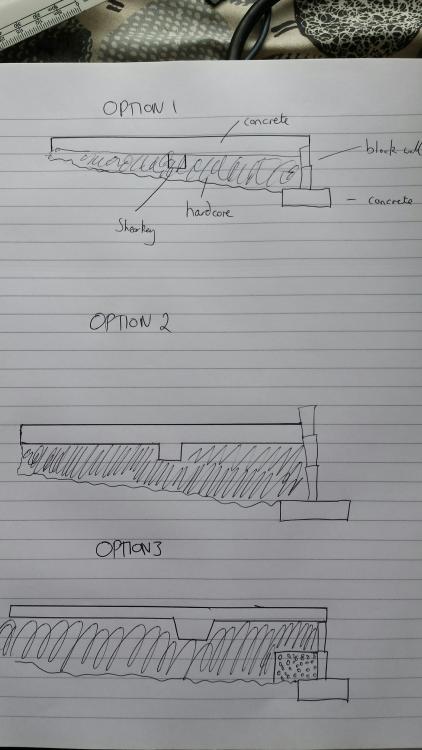Search the Community
Showing results for tags 'concrete foundations'.
-
Hi guys, I have a question regarding my garage slab, I'd just like to see what you guys think and also what you may have experience with. I have attached some sketches to help explain this. My garage site is on a slope, it slopes to the back. I dug out and poured at the rear elevation a C35/40 foundation 400-450mm wide and min 200mm deep. I then built a 2 block high wall, I may add a single row of engineering brick along the top to get the level spot on, so this is going to become the rear wall. It was done like this because of the slope, the amount of shuttering and the strength of said shuttering would have been fairly heavy duty and because of the proximity to the neighbours it would mean needing to remove mature hedges to build the shuttering structure - their only stipulation when I said I wanted to build this garage was to leave the hedges, although they are my hedges I have respectfully done this. The rear found and wall also forms a back shear key of sorts to help support the slab and stop it slipping (there will be another mid-point shear key cast as part of the slab). It's all quite well thought out and a civil engineer gave me the design spec but I have got some questions now. I was thinking about the slab and how it will work in relation to this little wall, the next stage would be to attach 6x2/8x2 to the wall running up to the front to form the shuttering. The concrete will then fill the shuttering up to the rear wall, but my concern is that the slab could push upon this wall and potentially push it out in the future if there was any slippage or settlement. So I have decided that I think the slab should sit on top of the small block wall, this would then mean that the rear wall would restart on the slab, and if slippage settlement occurs it would be less likely just to push out the rear wall - instead the wall would move with it. So I would build the shuttering to the back of the wall and let the concrete sit on top of the wall. I would need to insure that the infill was very well whacked to ensure the slab didn't settle on the inside of the wall and crack as it cannot move because of the wall. I was tempted to make up a no-fines concrete and back fill on the inside of the wall so that it was a bigger concrete base. I have sketched out some thoughts and options. I am an engineer so I tend to look at things in every fine detail, but not being a structural/civil engineer I can only start letting my mind run away with ideas and thoughts that I don't have training in.

